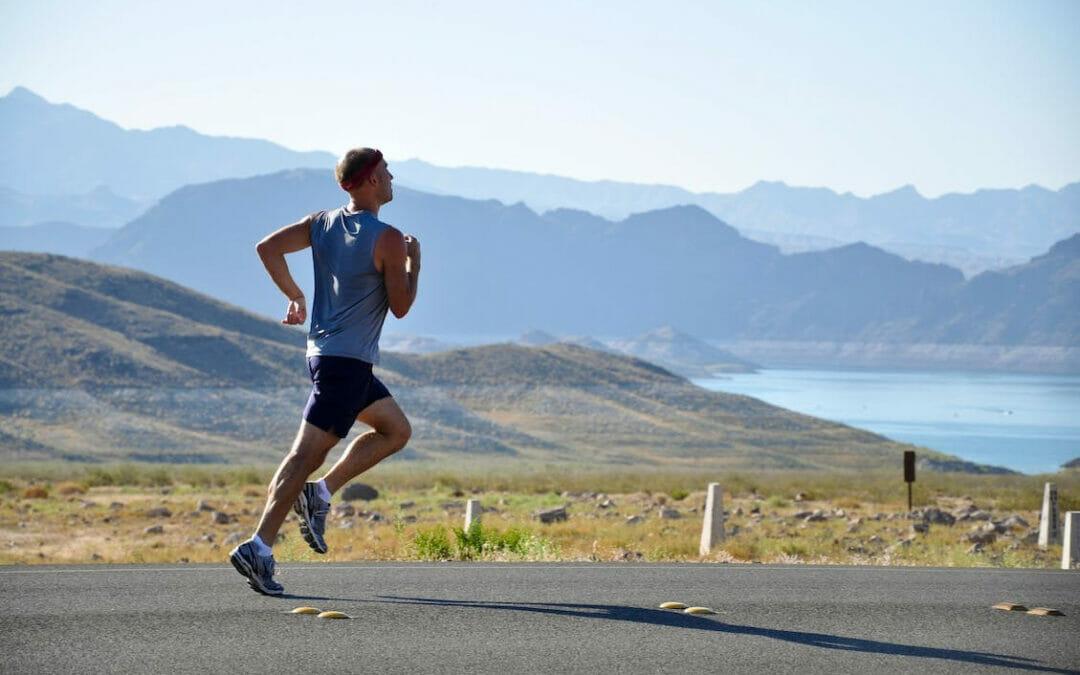
How to Maintain Fitness and Wellness Habits: Tips and Techniques
Maintaining your fitness and wellness habits can be challenging, especially when life gets busy. However, developing simple and effective strategies will help you stay on track and keep your health a priority. This article will provide you with a comprehensive guide to staying fit and healthy, complete with tips and techniques that you can implement in your daily routine.
Build in Daily Exercise
One of the easiest ways to maintain a fitness routine is to build in daily exercise. Even if you’re busy, there are several ways to fit in exercise that won’t take up too much of your time. For instance, try parking farther away from your destination and taking the stairs instead of the elevator. You can also use your lunch breaks to take a brisk walk or run.
Challenge Yourself with a Running Coach
If you want to take your fitness routine to the next level, consider working with Brad Minus from Inner Fire Endurance Sports to build your endurance. A coach will push you to achieve your goals and hold you accountable for your progress. Additionally, they will provide you with personalized advice and tips to ensure that you’re training in the most effective way possible.
Give Yourself Positive Affirmations
Incorporating positive affirmations into your daily routine can help you stay motivated and confident in your health journey. Start by telling yourself positive things in the mirror every morning. Repeat phrases such as “I am strong,” “I am healthy,” and “I am capable.” Before long, you’ll start to believe it, and your mindset will shift toward positivity.
Set Healthy Boundaries
Setting healthy boundaries is crucial if you want to maintain your fitness and wellness habits. This means saying “no” to things that interfere with your workout routine, such as late-night plans that will make you too tired for an early morning workout. Prioritize your health and protect your boundaries to ensure that you won’t be distracted or derailed from your goals.
Unplug Regularly
In today’s digital age, it’s easy to be consumed by technology, making it even harder to find time for exercise or self-care. However, it’s essential to unplug regularly and give yourself time to recharge, both mentally and physically. Try taking a break from social media for a day or two or turning off all electronic devices in the evening to help your mind unwind.
Create a Clean and Organized Home Environment
Maintaining a clean and organized living space is essential for promoting a healthy lifestyle. A clutter-free environment can contribute to a sense of calmness and reduced stress levels. Additionally, having ample space in your home allows you to easily incorporate physical activities like workouts or yoga sessions into your daily routine.
If you struggle to keep your home clean and organized, there are a few tips and tricks that can make it easier. Try to minimize clutter by getting rid of anything that you no longer need or use. When vacuuming, make sure that you empty your vacuum regularly to maintain full suction power. Next, establish a daily cleaning routine, such as doing a load of laundry each day or washing your dishes immediately after using them.
Maintaining your fitness and wellness habits requires a deliberate and consistent effort. However, incorporating simple and effective strategies into your daily routine can make a significant difference. Building in daily exercise, unplugging from technology, and maintaining a clean and organized home environment are all essential components to staying fit and healthy. By implementing these tips and techniques, you’ll be on your way to achieving your goals and living your healthiest life.
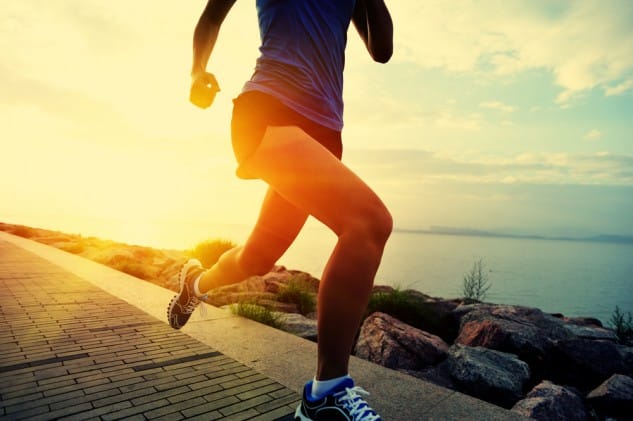
6 Tips For Quality Run Training
Tips for Quality Run Training
- Train no faster than one pace quicker than the race you are training for. For example, 5k pace is good for an Olympic-distance race, while half-marathon pace suffices for IRONMAN training.
- Distinguish what your greatest limiter is. Is it physiological, i.e. engine capacity, specific fitness, ability to tolerate heat, ability to process calories? Or is it a mechanical ability to sustain pace? Work specifically on these limiters.
- Your greatest fitness gains will come from accumulating as much threshold and subthreshold (tempo) work as possible but see the previous two bullets again to guide you. Remember, easy running should still form the bulk of your work.
- Do anything faster, like VO2 max work, if your event needs it (like a sprint race), either on an incline, i.e. hill repeats, or on the bike such as all-out 30 second efforts.
- Try to simulate race conditions on a regular basis to see how your run holds up under those conditions, loads and speeds. Being very fit and being able to hold a specific pace on a flat course under cool conditions does not add up on race day if you have hills, heat and a tough windy bike to contend with.
- If you don’t lose a lot of speed off the bike relative to your open run ability, don’t overdo the brick-work; it’s risky training of little physiological value. Evaluate your workouts in terms of what run training you need versus running that you feel you have to do to be confident on race day. These are often not the same thing.
- Determine whether you hold your form during the course of your run in a race. You can ascertain this with early and late video during longer quality sessions. Address what shows up. It will always be related to fitness and fatigue, but the fixes may come from either more specific training or some supplemental work in the gym.
Do you have any other tips for training?
Please leave a comment with your tip

Yamuna Body Rolling – Better than Foam Rolling?
 Being immersed in the fitness industry provides me with a ton of different opportunities to experience different techniques, methodologies, and products. I recently had the privilege of a one-on-one demo of the Yamuna® body rolling technique that focuses on myofascial release.
Being immersed in the fitness industry provides me with a ton of different opportunities to experience different techniques, methodologies, and products. I recently had the privilege of a one-on-one demo of the Yamuna® body rolling technique that focuses on myofascial release.
Recovery
Most runners, triathletes and other endurance athletes tend to neglect recovery. Why? Well, let’s face it, it could get kinda boring. Yoga classes are slow-moving, pose-to-pose movements, and foam rolling isn’t done at the break-neck pace we prefer. But, if you have ever been injured, one of the first questions asked is “would it have happened if I spent more time stretching and recovering?” The answer is commonly “Yes”.
Yamuna® body rolling is another technique to incorporate myofascial release into your fitness regimen. Myofascial release is basically a technique that provides stretching, compression and sustained pressure into restricted areas of connective tissue in the body to eliminate pain and restore motion.
Benefits of myofascial release techniques like Yamuna Body Rolling include:
- Increases blood flow. …
- Improves muscular range of motion.
- Reduction of muscle soreness.
- Maintains normal functional muscular length. …
- Encourages movement of your lymphatic system
The Yamuna Body Rolling Technique
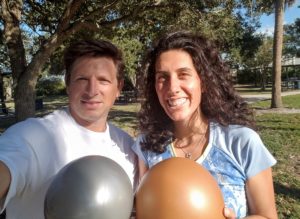 I had the pleasure of meeting Emily Stein, Certified Yamuna® Body Rolling Practitioner, and Personal Trainer who specializes in flexibility and mobility training using soft medicine balls and Active Isolated Stretching, located locally here in Tampa. She put me through a thirty-minute hands-on demonstration of this technique which uses different sizes of synthetic balls instead of a tubular foam roller.
I had the pleasure of meeting Emily Stein, Certified Yamuna® Body Rolling Practitioner, and Personal Trainer who specializes in flexibility and mobility training using soft medicine balls and Active Isolated Stretching, located locally here in Tampa. She put me through a thirty-minute hands-on demonstration of this technique which uses different sizes of synthetic balls instead of a tubular foam roller.
My mention of my tight hamstrings queued Emily to start my demonstration of the Yamuna® Body Rolling technique with my glutes. I sat on a medium-sized ball and rolled the ball slowly and deliberately throughout the range of my gluteus muscles and then slowly crossing down in my hamstrings.
Personally, I don’t use a foam roller, I use a PVC pipe because I enjoy pain. Well, not really but I find that it triggers more nerve receptors signaling where I need the release. Not that I have not used a foam roller. I have. I understand the use of a softer medium as it tends to mold to the area being worked on. The balls do the same thing, but because they are even softer than a foam roller they are able to cradle the muscle thereby triggering the release of more of the connective tissue. At least that is what I was experiencing.
Emily demonstrated not only the self-recovery techniques but also her incorporation of the Yamuna® balls into her personalized individual service. This one-on-one service where she uses her hands in concert with the Yamuna® Balls stretches deeper into the meat of the muscle while releasing of the connective tissue.
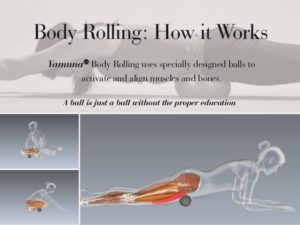 It was eye-opening how the balls release different points that are the foam roller is unable to target. Rolling around in a circle versus a linear motion, allowed by the Yamuna® Balls, signaled more points needing of release, in my opinion.
It was eye-opening how the balls release different points that are the foam roller is unable to target. Rolling around in a circle versus a linear motion, allowed by the Yamuna® Balls, signaled more points needing of release, in my opinion.
The Recommendation
I am sure you can see how the Yamuna® Body Rolling technique is advantageous to runners and endurance athletes. The pounding we put on our bodies causes all sorts of issues with not only muscles but our connective tissue. Just for this reason, I continually suggest incorporating massage, by a licensed massage therapist, at least once every two weeks. This technique, in tandem good stretching sessions, or yoga, will be beneficial in-between visits to your Licensed Massage Therapist.
It is, at the very least, worth a try.
If you would like to schedule some time with Emily Stein, or just inquire for more information, you can contact her through her website at www.rollforfitness.com. Emily helps people who need to and want to improve their movement.
Carpe Vitam!
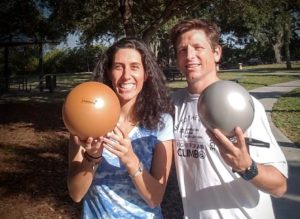
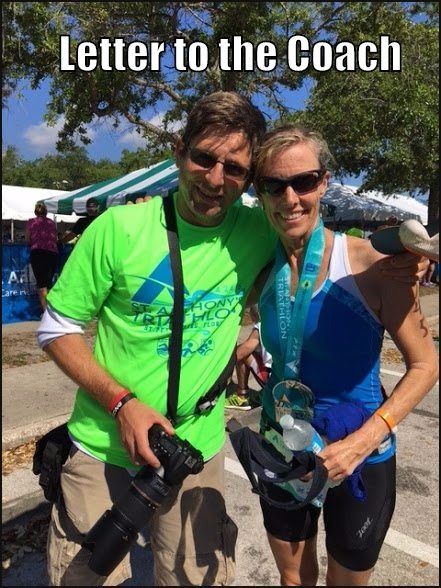
Letter to the Triathlon Coach
I have been an endurance coach for some time now. Once in a while, I receive an email from a client which chokes me up with pride. Today, I received one of those letters, so instead of sharing it via a Facebook post, I decided to copy it here.
The Letter
“Hello, Brad,
To reflect for a moment – It’s been about a year that you’ve been my coach. I have learned so much more than I ever would from a book, hanging out with colleagues, or trying to figure it out by myself. When I met you, I had been trying for years to run past 3 miles and frequently injured myself — I could never get past 3 miles was super frustrated, hated running, and I was very slow. In fact, none of my times in any of the sports were improving. After a couple of months working with you on form and technique, I tripled the number of miles I could easily run, I increased my speed and had absolutely no injuries. You have inspired me to try things I would never consider trying, regularly pushing me out of my comfort zone and helping me accomplish things I didn’t think were possible or I would ever have the guts to do (e.g., swim in cold water– you have no idea what a big deal that is– running a 10K, and riding in bike groups).
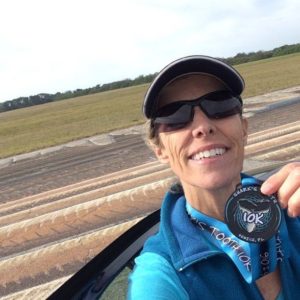
I felt like I couldn’t find anyone that would be interested in coaching me as an age grouper and being new to triathlon. Finding you was such a blessing because I feel like you treat me like a pro– you respect me for where I am, what I am trying to accomplish, and my repetitive silly questions (e.g. What is “PR?”). Your positive attitude is contagious and inspiring.
Everything you have taught me has been instrumental in reaching my triathlon goals and even helping me win the FD3 Series in my age group! That’s pretty cool! You’ve also worked around my schedule and needs to perfectly tailor the perfect program for me as an individual and because of that, I’ve gained improvement in running, swimming, and biking. I’m really grateful you don’t just prescribe a “one size fits all” approach– you related it to my personal needs.
I look so forward to our weekly calls, and knowing that someone is there holding me accountable, there to support me when I’m feeling discouraged, and perhaps more importantly, there to celebrate every success, no matter how big or small! It makes my day when I get random emails commenting on some aspect of my training. I can’t even begin to summarize how much I’ve learned from you. I’m constantly impressed by how well-informed and experienced you are– no matter how random I think my question might be, you always have an answer that is backed up by facts/literature/experience, etc.. Even when some random muscle hurts, your solutions have always worked!
I’m also thankful that you include the nutritional elements since that is a critical part of training and performa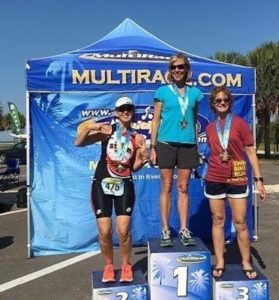 nce, as I’m slowly learning and trying to get better at communicating.. I had no idea how important all of this was.
nce, as I’m slowly learning and trying to get better at communicating.. I had no idea how important all of this was.
So, in about 8-10 months of working with you, I’ve tripled my running distance, increased my run pace by a couple of minutes, increased my bike speed by several MPH and have become a stronger, more efficient swimmer. I have completed two Olympics and several Sprints– without any injury! And it’s been a lot of fun, I’m totally hooked! I’m looking forward to the 70.3 journey (just one, I don’t have time to sustain that level of training!), and getting on the podium for an Olympic at some point ; )
I have complete trust in the process you are leading me through, and it is definitely generating results. I’m so grateful for who you are, what you do, and your passion.
So over time I say thank you– please know there is so much more behind just those two words– it’s hard to express all the gratitude and appreciation that is in my heart and mind. So again, thank you. ~ Laura”
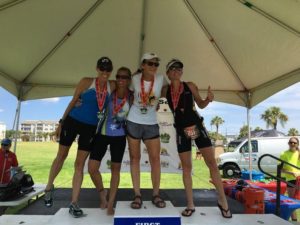
From the Coach
This was written by my client Laura Engleby whom just as she has detailed, took 1st in her age group in 2 of the FD3 Series Sprint Triathlons and 3rd in the last one. These accomplishments gave her 1st place for the series. She also took 4th in her second Olympic distance triathlon. She put in the work, took the prescribed suggestions and followed the plan we made for her.
I cannot even put into words how proud I am of this woman and what she has accomplished in the short amount of time I have been privileged to be coaching her.
Carpe Vitam!
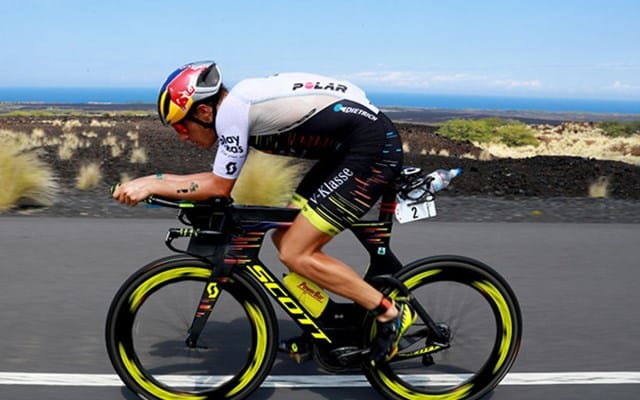
Get Faster on the Bike with these 5 Tips
I found when looking for ways to get faster on the bike, is that there is so much information, from different coaches and experts, that it can be confusing and overwhelming. Personally, I enjoy having so much information as it allows me to try different methodologies to find what works for me, and for my client athletes. Here are a few ways to increase your speed on the bike, that in my experience has worked quite well.
Increase Your Pedaling Efficiency to Get Faster
How does a bike move? The circular motion of the pedals, right? How do you create that motion? You push down on the pedals which moves the crank in a circle. That is one way. The question would be, is that the most efficient and does it propel the bike with the full potential of the rider? Not necessarily.
Most novice bikers tend to only push down on the pedals as I mentioned prior. That is only half of it. One of the reasons most cyclists and triathletes use bike shoes and clip-less pedals is not only to keep feet firmly in place, but the fact that it allows for two points of power; Pushing down on the pedals using the quadriceps, and pulling up using the hamstrings. An effective analogy that helps to turn the grinder (push only) cyclist into a more efficient one, is imagining the full rotation of the crank as a clock.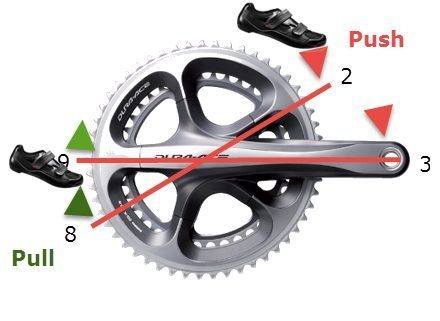
The penultimate, or switch, from push to pull of a single leg, might take place at the 9-3 or 2-8 positions. Be that as it may, every rider is different, so the penultimate may be different. In other words, as your foot rounds the 9 position, switch from pushing down to pulling up one foot while doing the opposite on the other. If you try this on your next ride, it most likely feels foreign. The best way to overcome that is to incorporate single leg drills into your warm up.
How to integrate better-pedaling efficiency
I prescribe my clients 100 single leg rotations on each leg with 1 minute of an easy spin in between as a warm up to every ride. This allows the initial leg to keep moving while receiving power from the opposite leg, and allow you to feel tension around a full rotation.
At first, you may feel a chunking in your stroke. That is just the crank telling you it does not have full tension all the way around the “clock”. Find a gear where you know longer feel or hear it and then continue with the exercise. Soon it will not matter what gear you are in. Finding that smooth, full pedal stroke will be an epiphany that will allow you to gain even more speed.
 Ride Hilly Courses to Get Faster
Ride Hilly Courses to Get Faster
Even if your event is flat, you will find an advantage to pedaling up hills. Steep hills will challenge your cardiovascular system while long hills will increase your strength.
A good amount of triathletes tend to fade away from doing hilly races because hills are a challenge. If only they would remember Isaac Newton and the law of gravity. What comes up must come down. While it might be a challenge going up, there is recovery on the way down.
How to integrate riding hilly courses
Start with a flat course that includes a couple of short hills and ride it a few times repeating the hills. Then find an area that includes a loop or out and back courses that is mostly hills or a good combination, and add loops for a few workouts.
I do not suggest finding a group that does hills on a regular basis and jumping in without conditioning yourself to take on different lengths and grades of hills.
Complete Best Effort Interval Workouts and Get Faster
When I first started, I never thought to use the knowledge I gained completing track workouts would transfer it to the bike. I 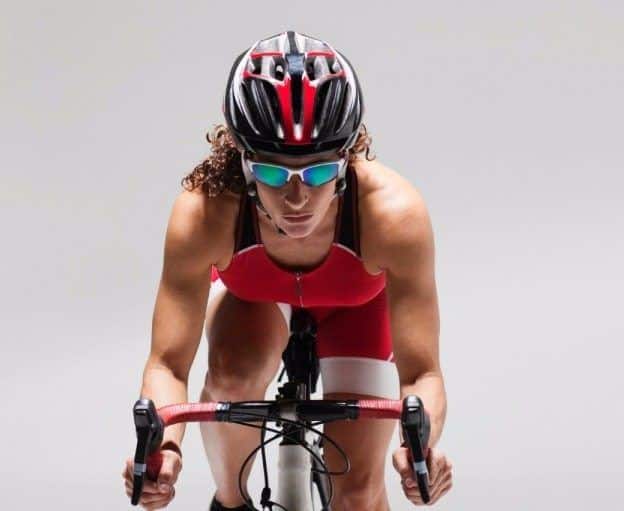 found that, for me, interval training, like on the track, it is one of the fastest ways to progress on the bike. If there is only one tip you take away from this article, take this one.
found that, for me, interval training, like on the track, it is one of the fastest ways to progress on the bike. If there is only one tip you take away from this article, take this one.
Intervals are designed to adapt other muscle fibers for use along with the main set of fibers. Endurance athletes engage slow-twitch, Type I muscle most of the time. By completing short bursts of high-intensity effort, the fast-twitch, type IIa, and IIb muscle fibers are integrated allowing us to gain their power for higher speeds.
Type IIa muscles can be utilized at the maximum for 2-3 minutes and type IIb only for about 30 seconds. How does this help? When these fast-twitch muscle fibers are used they increase the strength of the type I muscle fibers because they are not doing all the work for that time. The endurance muscle fibers are given some recovery allowing them to be used at a higher intensity later.
In-between the high-intensity intervals are high gear spins or low tempo efforts. The fast-twitch fibers can then recover as well. Fast-twitch muscle fibers can recover almost as fast as they are depleted.
Example of Best Effort Interval Workouts
Quick Note:
My clients usually have been riding and completing at least six months of medium intensity workouts before they are prescribed Best Effort workouts. I suggest having a very good fitness base before attempting a workout like the one below.
Here is one workout I assign my clients:
- Warm-up: 10 Minute Easy Spin
- Main Set: 30 Seconds Best Effort, 1-minute Easy Spin x 5
- 1 minute Best Effort, 3 minutes Easy Spin x 5
- 3 miles Race Pace, 1-mile Easy Spin X 5
- 30 seconds Best Effort x 1-minute Easy Spin x5
- Cool Down: 10 minutes 95+ RPM Spin
Best Effort is just what it says. The fastest you can go for that amount of time without regards to the rest of the workout. You will find that each of the intervals will be slower than the interval prior. If it isn’t, then you did not truly go all out or in other words, give your best effort.
Train with Power to Get Faster
I started training with power two years ago, and it has helped me get faster on the bike not only efficiently but with a lot less difficulty. A power meter provides you with the amount of torque, in watts, you are creating while pedaling at any given time.
The advantage here is that by calculating your Functional Threshold Power, you can train in and outside of your limitations to create strength and power which will result in more speed. Prior to training with power, I was constantly looking at three things. Speed, Cadence, and Heart Rate(HRT). I would also have to take into consideration the conditions and terrain I was training on. If it was hilly, my HRT would scream as I was riding the incline and my speed would reduce, and then the opposite on the decline. When the weather was windy, my HRT would elevate if I tried to keep my speed at my goal, so I would have to reduce it, in order to keep from bonking.
With a power meter, I only have to look at one number. By completing a test and calculating my personal Functional Threshold Power, I now only need to look at one number. FTP is the total number of watts I can average over an hour. Total watts is in my definition from ‘Fresh’ to ‘Dead’. Totally recovered to totally spent.
Obviously, there are certain races you do not want to race at your FTP or over. For example, a 70.3 triathlon; which includes a 56 miles bike after a 1.2-mile swim and before a 13.1 mile run following. If you ride at your FTP, you won’t have enough energy for the rest of the bike, let alone the run.
Goal Race Power
Through training, the object is to find the what your Goal Race Power will be. Usually, we think about it as a percentage of 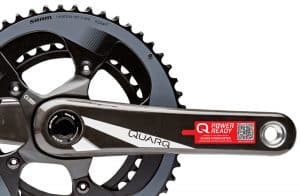 your FTP. Most triathletes can ride 90-95% of their FTP for a Sprint, 85-90% for an Olympic, 80-85% for a 70.3, and 70-75% for 140.6 triathlon events.
your FTP. Most triathletes can ride 90-95% of their FTP for a Sprint, 85-90% for an Olympic, 80-85% for a 70.3, and 70-75% for 140.6 triathlon events.
For example, if my FTP is calculated at 300 watts, then my goal race power for a 70.3 triathlon would be 184-195. That is the only number I have to look at. Instead of thinking about my speed, what my heart rate is, and then what adjustments to make for conditions, I only have to look at the one number.
If I have to climb a hill on the course, I increase the gear to a point that I stay in my power range. The same holds true for wind. My FTP takes in to account everything my body can handle. Sure, on a hill or in the wind my speed might be reduced, but my power will remain the same.
I no longer chase a certain speed on the bike. If I have to put out more watts than my goal race power in order to maintain that speed, then I will end up expending energy I need for the run. Unfortunately, power meters are not cheap. I can write several articles on types, brands, and accuracy of different power meters, so I will not go into that here.
How to integrate Training with Power
The first thing to do is calculate your FTP. It does not have to be done on an hour bike ride where you go all out for that hour. It can be calculated with one 20 minute ride.
After a solid warm-up, speed to what you believe is your tempo pace. Throughout the 20 minutes, build to a point where you are the absolute maximum effort for the last 5 minutes. You should be pretty spent at that point. Take the average power for that 20 minutes and multiply it by 0.92 and that will give you a good FTP to work with.
If you read any other more complicated articles on power, you will find that there are more specific ways of calculating your FTP that can help to make that number more accurate, but this is the most simplistic.
Now your workouts can consist of working percentages of that FTP for different objectives of your workouts. Speed work may include riding short intervals of 110-125% of your FTP, while for strength, you might ride longer intervals of 90-95%. To understand goal pace FTP, you might work long rides with long stints in variable percentages ranging from 75-90% FTP.
Strength Train to Get Faster
This tip can be looked at as either typical or far-fetched. The popular muscles for biking are mostly the quads and hamstrings, so why not do some squats, some leg curls, and the leg press and be done with it?
The question would be; what are your limitations on the bike? Do you even know if you have limitations? That would bring up the most important question, are you as good on the bike as you want to be? If your answer is “no”, then you have limitations.
The gym is the place to address those limitations and/or weaknesses and then turn them into strengths.
 How to integrate Strength Training
How to integrate Strength Training
Diagnose your limiters by testing your hamstring flexibility, your adductors and abductors, your core strength and leg strength. Then design a program to address those.
I suggest a strength session 2-3 times a week; one session for power, one session for endurance and agility, and a final session for movement and flexibility.
There are plenty of resources online to find the right movements to do for each session. Pay very close attention to the form of the exercise in order to reduce the chance for injury.
Summary
Everyone wants to get faster on the bike, but it only comes with work and working smart. Most posts keep re-iterating the same things. Good bike fit, ride more, faster-biking partners etc. I am hoping the points I have shared, are new to you or maybe just a little more specific.
Increasing your pedaling potential, riding hilly courses, completing best effort interval workouts, training with power and strength training are ways I found to get faster on the bike. They are current methods I prescribe to my own clients with great success. I hope they work for you too.
What are your plans to get faster on the bike? Do you know of any other methods?
Please comment below with your answers or any feedback you may have.
Carpe Vitam! (Seize Life)
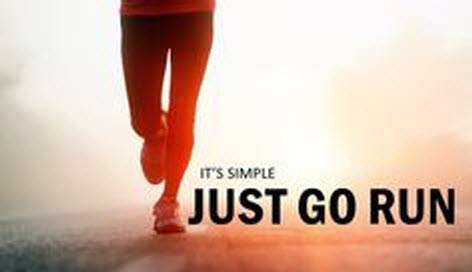
Workout Wednesday: Run Strength
Happy Hump Day! Workout Wednesday’s will consist of favorite workout of mine that I either have prescribed to my clients or have been assigned by MY Coach. It might also be a favorite of yours. Feel free to send me any workouts you like. There will be an objective for every workout for specificity.
Run Strength – Hill Repeats
I am not a huge fan of weights or being in the gym. As the summer wore on and Florida continued to increase in heat I found myself spending more and more time in the gym and on the treadmill, but I still prefer to be outside. This workout will work leg strength as a replacement for a gym resistance workout or a supplement to. It can be done either on the Treadmill or outside with a hill that takes 2-3 minutes to run up, or here in Florida we use parking garages.
WU (Warm-up): Run Drills & Dynamic Stretching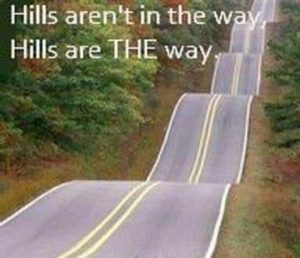
1-2 miles @ conversational pace
MS (Main Set):
Hill Bounders on uphill
Recover for 30 sec – 2 minutes
Speed over strides on Downhill
Repeat for up to 30 minutes
CD (Cool Down): 1-2 miles @ conversational pace
Lunges & Static Stretches
Objective: Leg strength, Aerobic capacity, Form Development & Confidence on Hills
Rate of Perceived Exertion (RPE): 5-7 on the uphills (Talking should be very difficult)
Description: Run a hilly course. Do not try to run fast on the uphills but rather concentrate on a good knee lift, strong arm swing, uplifted chest and full push-off extension in your back leg. Practice running efficiently on the downhills with high turnover and enough of a forward lean that your front leg lands directly under you.
Hill Bounders: go up the hill with a bouncy action and a good posture, concentrating on a good knee lift and arm swing with a “snap” with your ankle. You should be thinking Spring up the hill. Jog until recovered at the top.
Speed Over striders: Run down the hill with out breaking but increasing your cadence with the steepness of the hill. Instead of completely striding out elongating your stride, focus on increasing your cadence with a normal stride.
Biggest Mistakes: Running too fast up the hill rather than concentrating on form. Running too hard up the hill and getting into too much oxygen debt. This is not desirable in this phase .Putting more stress on the legs than they are ready for with too much bounding or downhill running and getting injured. Precipitating your peak with repeated speed bursts. Some people tend to develop speed very quickly once they start doing the hill circuit. If this is the case, go very easy with downhill striding and on the stride-outs. You’ll still have plenty of time to develop speed to maximum. Premature speed development would only lead to premature peaking and this should be avoided.
Warning: The first week of hill training is one of the times where injury is most likely to occur. This is a very demanding exercise, so be overly cautious and feel your way gradually. After about 2 weeks in this phase your legs could feel very tired and you may feel you’re actually slower. This is normal and will pass within a couple of weeks of consistently completing the workout.
I hope you enjoy this one. I know I do.
What kind of workout do you do for run strength?
Carpe Vitam!


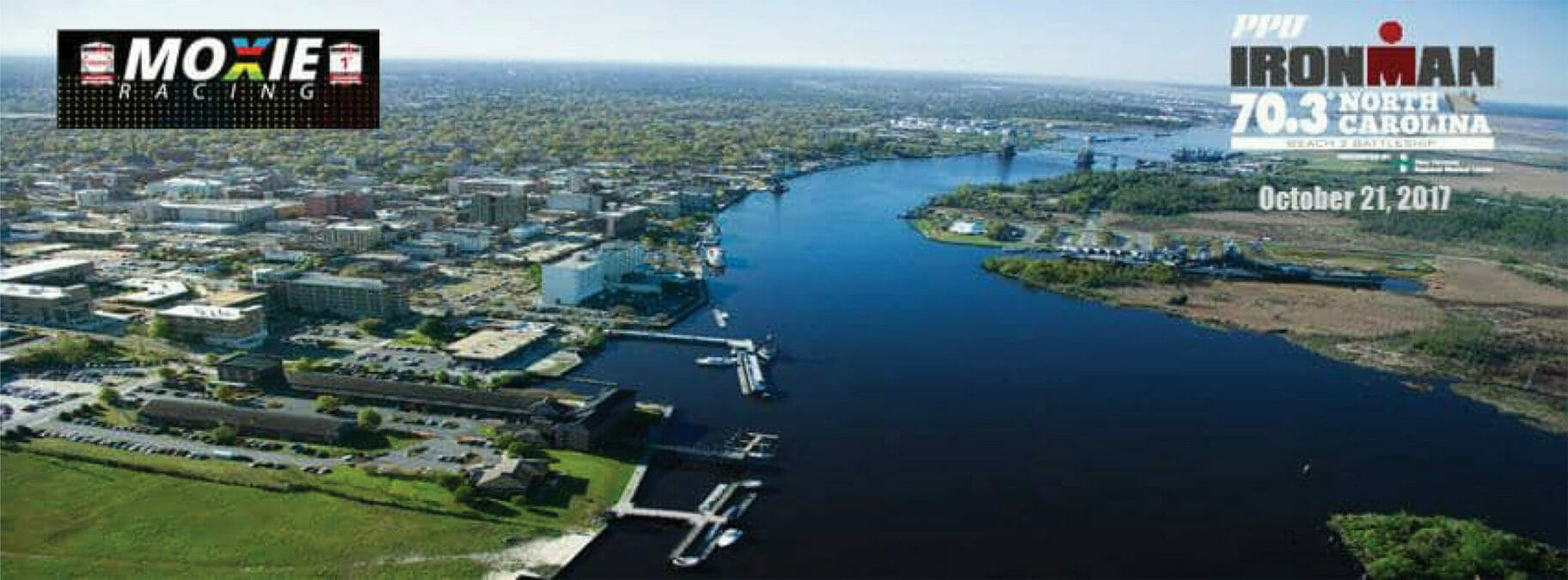

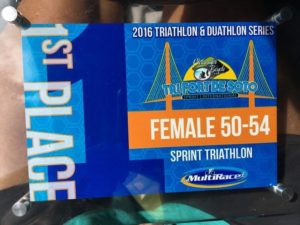
 Ride Hilly Courses to Get Faster
Ride Hilly Courses to Get Faster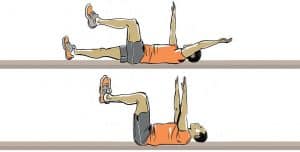 How to integrate Strength Training
How to integrate Strength Training